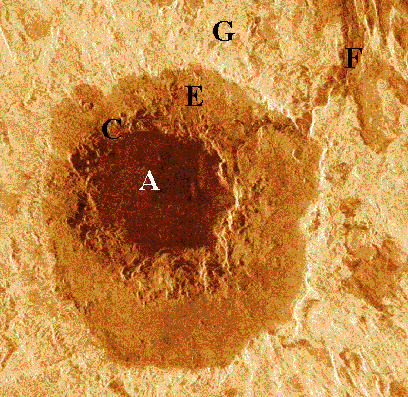Athena Review Image Archive
TM
Venus: Cleopatra Crater
 The double-ringed
crater Cleopatra is located in Ishtar Terra, the highest moutain range on
Venus, at coordinates
65.90 N and 7.00 E. Measuring 105 km in diameter, this prominent and somewhat
enigmatic feature is named after the famous Egyptian queen of the late 1st
century BC. Based on initial views from the Venera 15 and 16 orbiters, Cleopatra
was once considered to be a volcanic caldera. Higher resolution radar imagery
from Magellan, however, has shown it to be a peak-ring impact crater with
inner and outer basins, and a series of rough ejecta deposits.
The double-ringed
crater Cleopatra is located in Ishtar Terra, the highest moutain range on
Venus, at coordinates
65.90 N and 7.00 E. Measuring 105 km in diameter, this prominent and somewhat
enigmatic feature is named after the famous Egyptian queen of the late 1st
century BC. Based on initial views from the Venera 15 and 16 orbiters, Cleopatra
was once considered to be a volcanic caldera. Higher resolution radar imagery
from Magellan, however, has shown it to be a peak-ring impact crater with
inner and outer basins, and a series of rough ejecta deposits.
This view from Magellan shows the central floor (A) region appearing dark,
due to its covering of fine dust which reflects little radar. Beyond the
inner ring of the crater (C), a dark blanket of ejecta (E) represents
a relatively smooth layer spread over a lighter, radar-bright outlying zone
(G) characterized by rough terrain. This is crossed at rop right by a lava-like
flow (F) of surface materials melted by the meteor impact which caused the
crater, sometime after 300 million years ago.
[Fig.1: Radar image of Cleopatra Crater on Venus (NASA/JPL
Magellan).]
Athena
Review Image Archive™ |
Guide to Archaeology on
the Internet |
free trial issue |
subscribe |
back
issues
Main
index of Athena Review |
Subject Index
| Travel
Pages |
Galleries and
Museums |
Ad
rates |
Current
issue index
Copyright ©
1996-2003
Athena Publications,
Inc. (All Rights Reserved).
 The double-ringed
crater Cleopatra is located in Ishtar Terra, the highest moutain range on
Venus, at coordinates
65.90 N and 7.00 E. Measuring 105 km in diameter, this prominent and somewhat
enigmatic feature is named after the famous Egyptian queen of the late 1st
century BC. Based on initial views from the Venera 15 and 16 orbiters, Cleopatra
was once considered to be a volcanic caldera. Higher resolution radar imagery
from Magellan, however, has shown it to be a peak-ring impact crater with
inner and outer basins, and a series of rough ejecta deposits.
The double-ringed
crater Cleopatra is located in Ishtar Terra, the highest moutain range on
Venus, at coordinates
65.90 N and 7.00 E. Measuring 105 km in diameter, this prominent and somewhat
enigmatic feature is named after the famous Egyptian queen of the late 1st
century BC. Based on initial views from the Venera 15 and 16 orbiters, Cleopatra
was once considered to be a volcanic caldera. Higher resolution radar imagery
from Magellan, however, has shown it to be a peak-ring impact crater with
inner and outer basins, and a series of rough ejecta deposits.